How many stop-out students are you losing? The truth is, your year-over-year data might be hiding what’s really going on with your student retention numbers.
Enrollment may look stable, with numbers going up and down a little each year. But underneath the surface, there’s a significant loss happening.
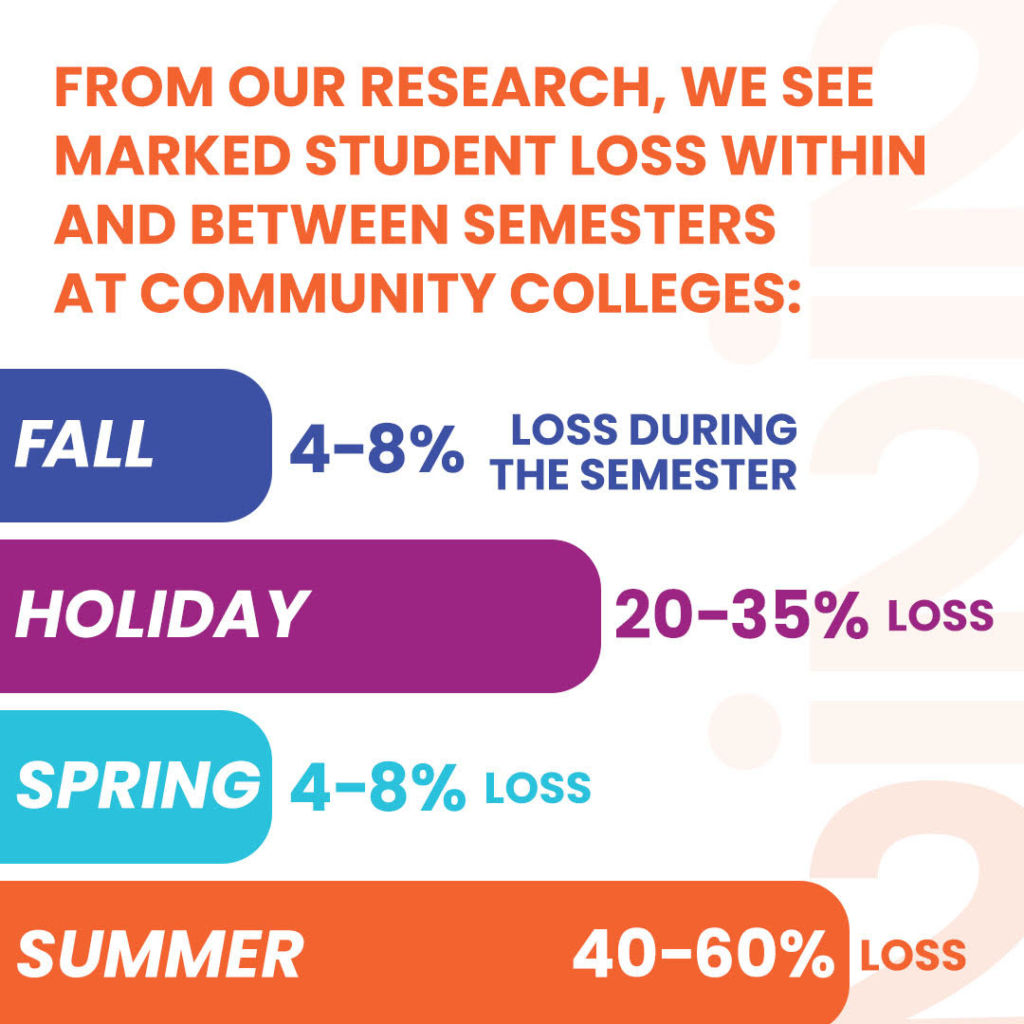
From our research, we see marked student loss within and between semesters at community colleges:
• During the fall semester, there is a 4-8% loss.
• Meanwhile, over winter break, community colleges typically lose 20-35%.
• Within the spring semester is a 4-8% loss.
• And over summer break, the dreaded “summer melt” loses 40-60%.
So, Let’s say you started with 1,000 students in the fall. By the end of the summer, if we account for just the lower end of these percentages, you’d be left with just 442 students — less than half of who you started with.
But these numbers often do not surface because fresh students replace those stop-outs. Colleges recruit anywhere from 30-50% of new students every year, making enrollment seem stable when it’s really not. And thus, the cycle continues.
“A riptide of churn is going on,” explains our CEO, Dr. Pam Cox-Otto. “You’re losing huge numbers of your students, replacing them with fresh faces, who you are again churning out — spitting out half of them over the year.”
With this kind of instability, all that has to happen is two crises line up — a pandemic and a seismic shift to online learning. And that’s where you’ll see enrollment plummet.
So, what can you do to fight high volatility and churn to make your retention marketing strategies truly stable?
1. Target Your Stop-Out Students Early and Often

Stop-outs are the single largest audience that you could go after. And they are also the demographic that can make the quickest decision to come back.
“Go after your stop-outs like God’s own thunder year-round,” advises Cox-Otto.
Stop-outs don’t transfer or graduate; they just don’t come back. And since the typical community college loses students at a rate of about 50% or higher, this audience will only continue to grow.
Yet, you already have these students’ personal information. So, email, direct mail, and even text them with warm reminders to return.
Additionally, you can take your existing student contact info, match it with your ad campaigns, and follow stop-outs around digitally. You don’t have to pay to reach the public — you’re just paying to reach the people you used to have.
“If you are in a state with variable funding, let’s be honest — the current students and the stop-outs are the holy grail,” says Cox-Otto. Since these demographics count toward enrollment as well as for students who have completed their entire educational journey, they are a win-win.
“It’s the largest part of your enrollment, and frankly, it’s the place where you can get the quickest results.”
2. Make It Easy for Stop-Out Students to Reapply
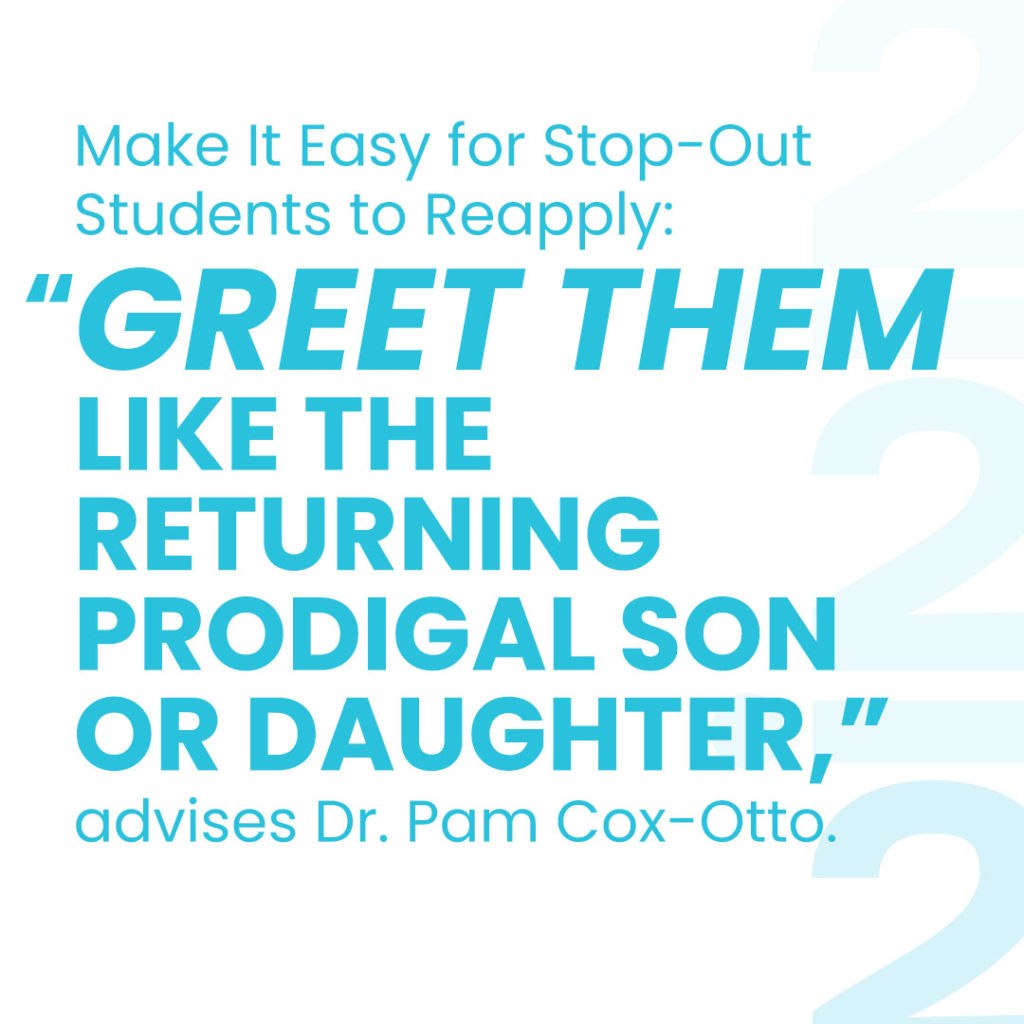
A word to the wise: If stop-outs do come back, be kind. Make their return home easier.
“You’re really mean to returning students — many of you make them reapply after only one or two years,” says Cox-Otto.
Streamline the returning student journey any way you can, and encourage these learners to come back where they belong:
- Can you make a shortcut for returning students?
- What about creating a landing page to help returning students get onto the fast track?
- Or, can you directly connect students with an adviser to help get them back in class immediately?
You might be surprised at how many stop-outs are only a few units short of a degree. And those students who failed to return might be surprised, too! Remind them how close they are to the finish line and encourage them to continue.
Don’t make stop-outs go through all those new student hurdles. Instead, welcome them home in your retention marketing strategies.
“So often, we greet them like, ‘Who are you again?’” says Cox-Otto. Instead, “Greet them like the returning prodigal son or daughter.”
You could even talk to your foundation and see if you can help these students buy their textbooks. Get creative, and make it oh-so-easy and encouraging to come back to college.
3. Before Transitions, Send Kind Reminders
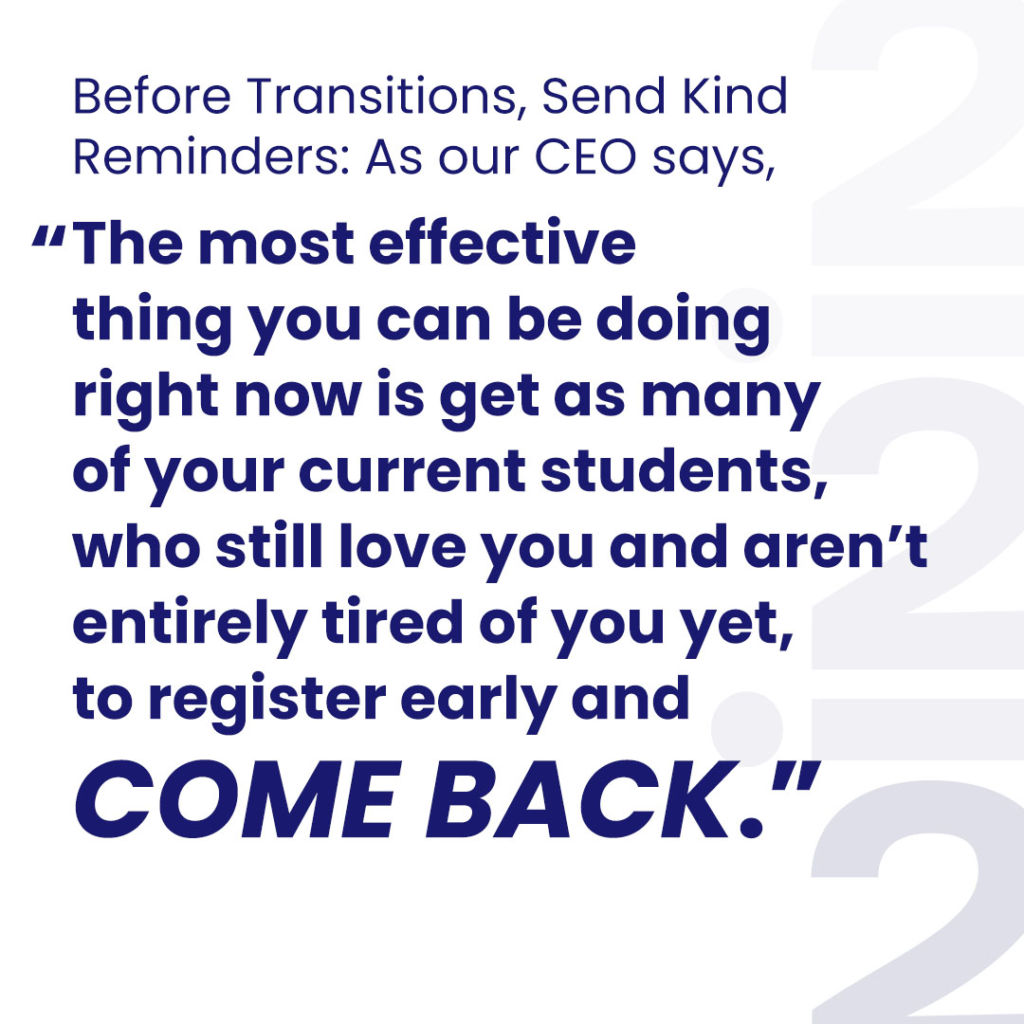
As we mentioned, the transition over the winter and summer breaks is when colleges typically lose the most learners as stop-outs.
Unfortunately, this is also a time when colleges stop sending relational messages. Instead, they deploy cold, transactional reminders about bills and overdue library books.
It’s time to try a new tactic. Before students leave campus, send out warm reminders of why students came to your school in the first place. Innumerate the many benefits they will get out of completing their education.
Most of all, encourage learners to register early. Once you get students to sign up, you’ll have a better chance of retaining them over the long breaks. Create a custom communication campaign that lasts at least three weeks before finals — before students are stressed. Get them thinking about reregistering early and convince them to commit.
If you’re not open for registration yet, then build in some touchpoints to get them thinking about it. Encourage them to make an appointment with their counselor, and have faculty reach out to see how they can support their students.
This is timely advice for April and May to stop the stop-out drop.
As our CEO says, “The most effective thing you can be doing right now is get as many of your current students, who still love you and aren’t entirely tired of you yet, to register early and come back.”
4. Pinpoint Within-Semester Loss and Fight It
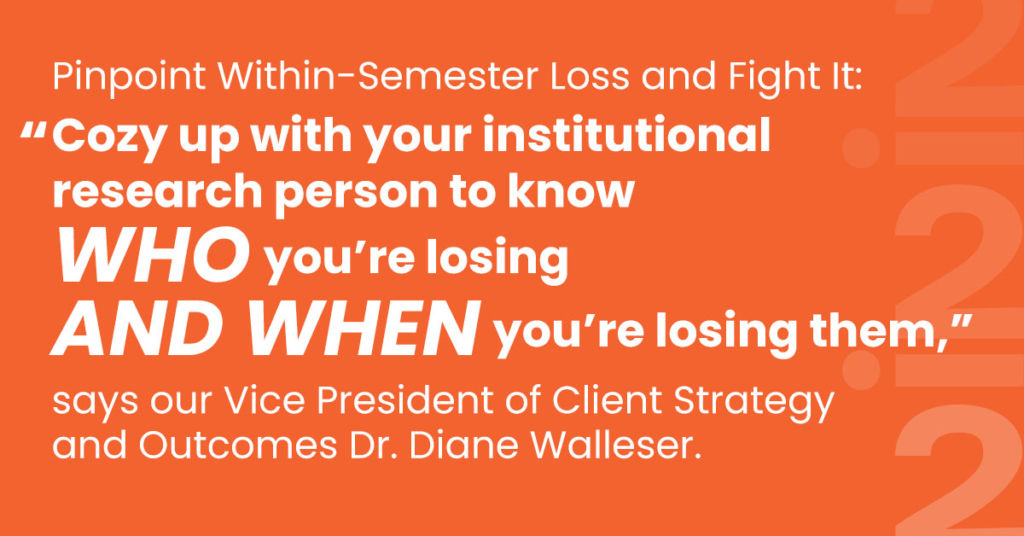
Look at your institutional research and discover where students get lost during the semester. Typically, students are volatile from midterms to the end of the semester. If they didn’t do well on midterms, then they are likely to “fast fail,” and you are in danger of losing them.
Take some advice from our vice president of client strategy and outcomes, Dr. Diane Walleser:
“Cozy up with your institutional research person to know who you’re losing and when you’re losing them.”
At her last institution, Walleser went through the data and discovered the college was losing fast fails with a high school GPA of a C. In response, the community college created mentor and peer groups for that specific audience to slow the drop.
“We also found that we lost students who didn’t take summer courses,” recalls Walleser. So, on top of beefing up communication, they offered more programs that ran for an entire 12 months. This tactic made a huge difference in keeping students coming back.
Wherever your big drop starts, send out messaging at least two weeks ahead and two weeks behind it to slow that drop. Keep your communication simple, warm, and encouraging, and keep your numbers from dipping.
5. Leverage the Start of the Semester
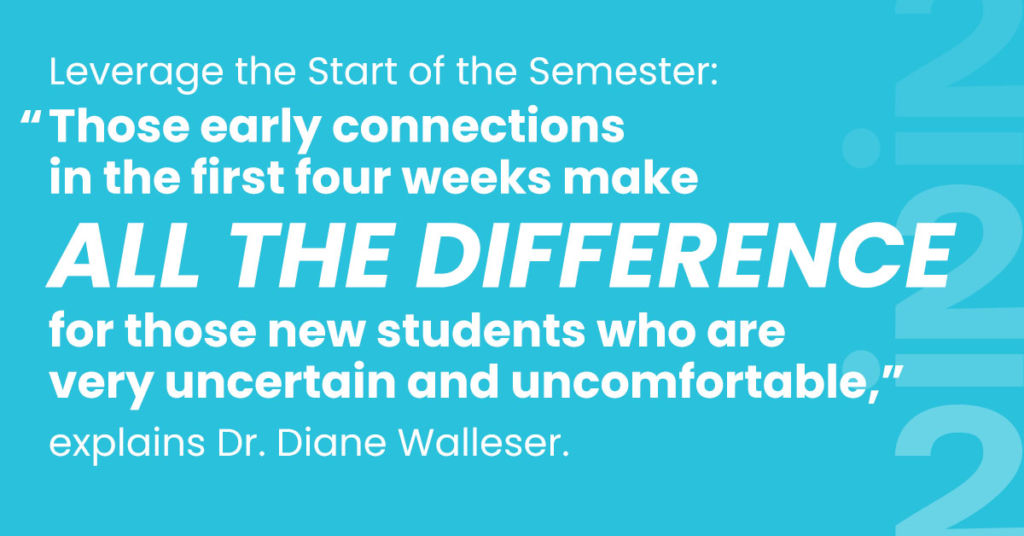
The best way to keep students within the semester is to get off on the right foot. Colleges have four to six weeks at the start of each term to really engage new students.
Walleser recommends reminding students of simple things like the following:
- Directions to the bookstore
- How to access tutors
- Foundational student services
- How to join clubs
“Those early connections in the first four weeks make all the difference for those new students who are very uncertain and uncomfortable,” explains Walleser.
From social media posts to friendly email reminders, give learners a map of a successful student journey. And don’t forget to get your faculty and student ambassadors on board! We’ll cover those strategies a little later, but first …
6. Review and Rewrite Internal Messaging
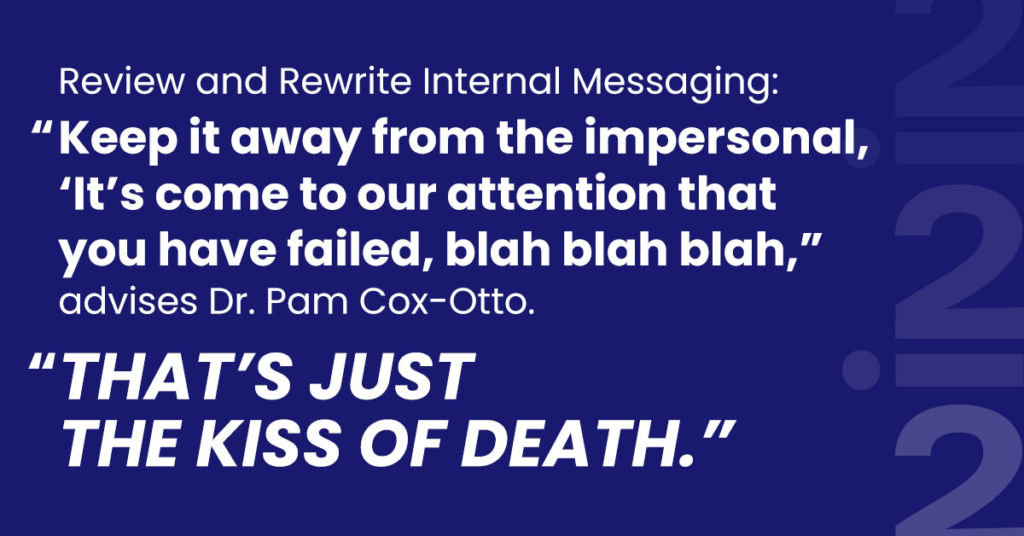
Round up all your messaging from instructional resources and student services and put it under a magnifying glass.
Is the language too transactional? Then rewrite it for humans! Let people feel the warmth and care you have for them. Most of all, let them know you have their backs.
“Keep it away from the impersonal, ‘It’s come to our attention that you have failed, blah blah blah,’” advises Cox-Otto. “That’s just the kiss of death.”
A little support can go a long way in keeping current students from becoming stop-outs.
7. Get Your Faculty on Board
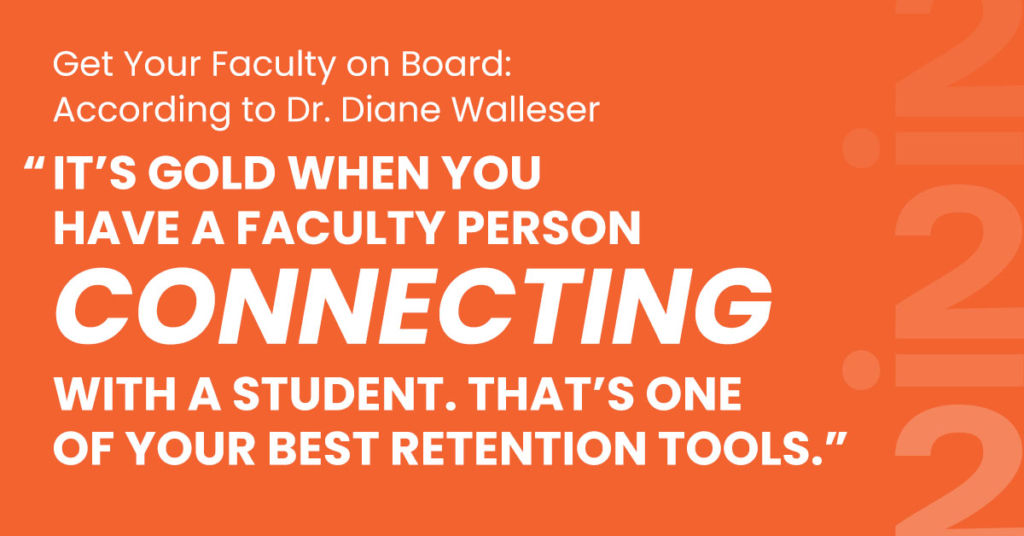
Toward the end of the semester is a great time to get your mentors talking to students about how they can support them.
Since faculty are busy, Walleser recommends giving them a helping hand. At her last institution, the communications department wrote customizable templates for department heads, who then had their faculty send the messages out to students.
“If we ask them to write the messages, it’s probably not going to happen,” says the pragmatic Walleser. “Think about how you can play the role to help some of these faculty and department heads be that frontline person to the student.”
Faculty support and encouragement at the right time can turn the tide for students. When Cox-Otto does consultations at colleges, she’ll often look faculty in the eye and say, “I can send 200 emails as a marketer that will never have the impact of one text from you.”
Our vice president of client development, Mary DeLuca, had great success at her last institution drafting customizable emails for faculty to share with their class lists. Her marketing department got buy-in from the deans and department chairs from all the program areas. DeLuca says, “It needed to come from their faculty leadership, and then it was successful.”
Walleser adds, “It’s gold when you have a faculty person connecting with a student. That’s one of your best retention tools.”
8. What’s the Best Way to Send Supportive Messages to Students?

With so many modes of communication, what are the best ways to reach students?
“Text, text, text,” emphasizes Walleser, especially if colleges have a two-way texting tool. That way, if you send a message about registering for classes, students can respond. If they need help, then you can connect them right away with an adviser or other support. Says our VP of client strategy, “If you have students doing this, that’s highly engaging.”
Emails are also effective, but they need to be exciting.
“It’s got to have some snap to it, and it’s got to be something they need right now, or they won’t respond,” says Walleser.
Cox-Otto adds, “Put things they value in the subject line so that they click on it and open it.” And she says to be sure to regularly check your email analytics so you can see what’s working and keep on doing it.
But don’t discount connecting via phone. According to Walleser, that can be a powerful tool as well.
“Students go, ‘Oh, I didn’t know anybody cared about me,’” says Walleser. “They really appreciate you calling.”
When learners are in danger of becoming stop-outs, have your faculty call. Or, for another powerful impact, have their peers pick up the phone. This brings us to our next topic …
9. Leverage Your Student Ambassadors
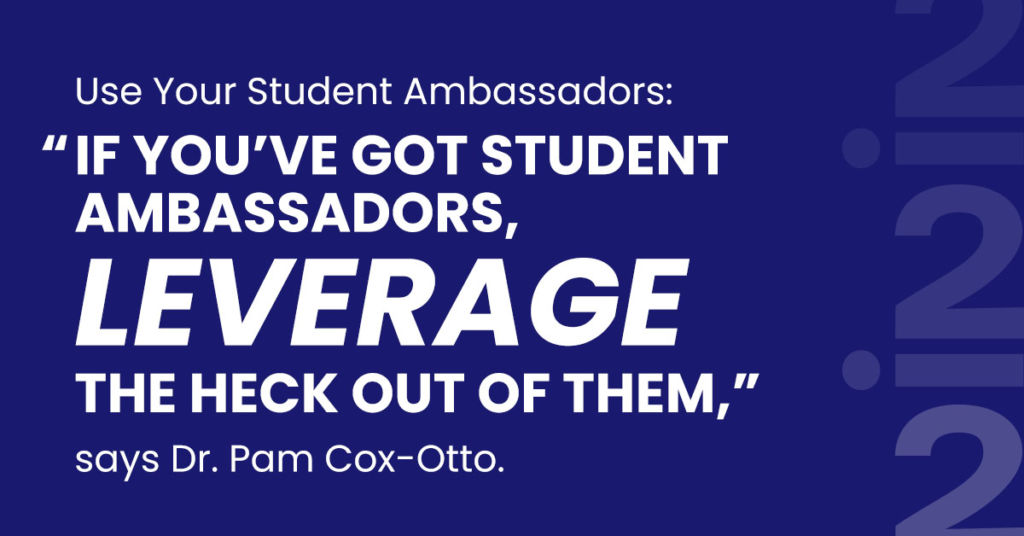
“If you’ve got student ambassadors, leverage the heck out of them,” says Cox-Otto.
First off, make sure you pay your student ambassadors and pay them well. Right now, Interact is working with a few college foundations to subsidize student ambassadors, bringing up wages to $25 an hour.
“If they can make $25 an hour at Target, and you’re only paying them $13 or $14, you’re going to have a hard time keeping them,” warns Cox-Otto.
Is it worth it? You bet. Overwhelmingly, students respond positively to peer support. And student ambassadors keep you from having to hire another faculty advisor or counselor for $80,000+!
On the path to stopping the stop-outs, you have to pull out all the stops. Here’s a summary of all the tips to help you retain students throughout their educational journey:
Key Takeaways: When It Comes to Stop-Outs, Don’t Burn Daylight
Year-over-year data hides that community colleges lose 50% or more of their students annually. Here’s what you can do to stop the churn and help students return:
- Target Your Stop-Out Students Early and Often: As Dr. Pam Cox-Otto says, “Go after your stop-outs like God’s own thunder year-round.”
- Make It Easy for Stop-Out Students to Reapply: “Greet them like the returning prodigal son or daughter,” advises Cox-Otto.
- Before Transitions, Send Kind Reminders: As our CEO says, “The most effective thing you can be doing right now is get as many of your current students, who still love you and aren’t entirely tired of you yet, to register early and come back.”
- Pinpoint Within-Semester Loss and Fight It: “Cozy up with your institutional research person to know who you’re losing and when you’re losing them,” says our vice president of client strategy and outcomes, Dr. Diane Walleser.
- Leverage the Start of the Semester: “Those early connections in the first four weeks make all the difference for those new students who are very uncertain and uncomfortable,” explains Walleser.
- Review and Rewrite Internal Messaging: “Keep it away from the impersonal, ‘It’s come to our attention that you have failed, blah blah blah,” advises Cox-Otto. “That’s just the kiss of death.”
- Get Your Faculty on Board: According to Walleser, “It’s gold when you have a faculty person connecting with a student. That’s one of your best retention tools.”
- What’s the Best Way to Send Supportive Messages to Students? “Text, text, text,” emphasizes Walleser.
- Leverage Your Student Ambassadors: “If you’ve got student ambassadors, leverage the heck out of them,” says Cox-Otto.
Straight Talk Webinar Insights and Client Exclusives
These tips and much more were shared at our April “Straight Talk Webinar” on churning versus returning students.
Straight Talks are client-exclusive events where our team of experts shares the latest tools and resources in higher ed, followed by a lively Q&A.
Interact hosts informative webinars, events, podcasts, and more. Never miss a beat, and sign up for our newsletter!
And before you go, just one more word of wisdom from our CEO:
Advises Cox-Otto, “If you don’t know exactly where that loss is coming from, and if you’re not focused entirely on stopping that 50% loss among your current students, you’re burning daylight.”
Featured in This Blog …
About Dr. Pam Cox-Otto
Part researcher, part marketer … and always a community college evangelist, Dr. Pamela Cox-Otto, Ph.D. brings an outside-the-box flair to everything she touches. Our CEO has been developing communications strategies for 30 years, infusing everything from branding to political advocacy campaigns with her unique, often humorous, tenor. Under her guidance, Interact has become the leader in community college research, recruiting and retention campaigns, college onboarding, bond initiatives, guided pathways communications, media relations, and statewide image and advocacy campaigns.
About Dr. Diane Walleser
As Interact’s vice president of client strategy and outcomes, Diane Walleser, Ed.D., ensures clients receive the custom research, marketing tool, or enrollment initiative to drive results. Previously, she served as vice president for enrollment management at Borough of Manhattan Community College, serving over 20,000 students. In 2013, Diane was awarded AACRAO’s SEM Award of Excellence for her leadership in strategic enrollment management at two-year institutions.
About Mary DeLuca
With 30 years of community college experience, our vice president of client development is eager to share her creative skills and strategic insights with other 2-year college professionals. DeLuca developed a nationally respected communications department and successful college brand from the ground up during her leadership tenure at Maryland’s Community College of Baltimore County (CCBC). Her team won an impressive collection of more than 100 NCMPR Paragon and Medallion awards.



